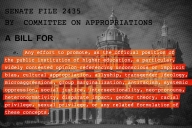You have /5 articles left.
Sign up for a free account or log in.
Last year, colleges were rocked by a series of protests over racial inequality on campuses and across the country. With signs pointing to those protests returning as students head back to campus this month, colleges and universities are preparing for another year of student activism.
Among those preparations, several institutions have begun offering new diversity and multicultural programming to their students.
“This isn’t a new area for higher education at all, but it’s clear that more and more campuses are recognizing it’s important to try and create more opportunities for open dialogue about these issues,” Kevin Kruger, president of NASPA: Student Affairs Administrators in Higher Education, said. “Most campuses understand that the protests and activism last year show that there are issues that need to be addressed.”
Students at the University of Missouri at Columbia must now complete mandatory "citizenship" training, a series of fall workshops that the university created after protests on campus last year, which included the football team threatening to boycott games and that led to the resignation and ouster of the university's president and chancellor.
The Citizenship@Mizzou training requires students to gather in an auditorium for group discussions, musical performances and speakers. Students are asked to share their opinions and questions about diverse groups. A student might say, for instance, that he believes Islam is more dangerous than other religions. Other students can then chime in, disagreeing with that student or asking him to elaborate on how he came to that conclusion. The meetings also include musical performances in which a song is performed in different genres -- Americana versus R&B, for example -- and students are asked to reflect on which version they were more comfortable with.
Starting this year, Oregon State University will require students to take an online "social justice" course that will act as a primer on "concepts of diversity and inclusion." Virginia Tech University required all first-year and graduate students to take a similar online course earlier this month. Called DiversityEdu, the online course, which is also used by several other institutions, is meant to help students acquire the "skills for engaging successfully with diversity and mitigating the influence of unconscious biases and stereotypical thinking on personal choices and professional decisions.”
The course includes readings and writing prompts such as "Describe a time when someone made a false assumption about you," as well as video reenactments of discriminatory and racist interactions.
At the University of Wisconsin at Madison, officials are piloting a new “community building program” with a focus on religion, sexual orientation, gender identity, class, nationality and ethnicity. The new program follows last year's anti-racism protests as well as a series of troubling incidents on campus, including Swastikas taped to the door of a Jewish student, racist slurs and threats directed at a black student through an anonymous note, and the heckling of a Native American elder during a healing circle.
Tensions were further flared in April, when university police pulled a black student from class and arrested him for allegedly spray-painting anti-racist messages across campus.
The new program will be offered to 1,000 incoming first-year students this year as a series of two-hour “in-person facilitated workshops,” Meredith Mcglone, a spokeswoman for the university said. The workshops will include structured dialogue, group activities, reflection and action planning. The university said the goal is to provide students with a broader awareness of diversity of social identities on campus, enhanced skills for engaging in constructive dialogue about those identities, and skills to detect discrimination and how to intervene.
“College is often the first time where people are exposed to people who are different from themselves,” Joshua Moon Johnson, special assistant to the university’s vice provost for student life, said in a statement. “Those could be religious differences, racial, socio-economic status, or sexual orientation. This pilot is an effort to definitely create some broad awareness of difference, not to tell people how to think, but to tell people how to critique the ways in which they think.”
Shaun Harper, executive director of the University of Pennsylvania’s Center for the Study of Race and Equity in Education, said there’s value in diversity and multicultural programs, but said that such initiatives can be ineffective if they are just a two-hour seminar or if they are connected to student orientation events.
“Orientation is a time of information overload,” Harper said. “These are 17- and 18-year-olds who are excited about getting off to college, who are saying goodbye to their parents. They have a ton of emotions. They’re not all that excited to sit through one session after another on one topic after another. I’m afraid that some diversity discussions get sort of lost because it’s all too much.”
Instead, Harper recommends that colleges organize ongoing first-year diversity seminars or that they find ways to “integrate diversity across the curriculum.” The Center for the Study of Race and Equity in Education is piloting a new survey tool this year that could soon help colleges make those changes, Harper said.
The tool is being tested at 100 institutions this semester, surveying freshman about what experiences they have had with different races, genders, gender identities, sexual orientations and religions. The responses can then be shared with a student’s academic advisor, Harper said, who will use the survey to help the student pick classes that might “introduce her to dimensions of diversity that she hadn’t been previously exposed to.”
Similarly, the survey could be used for determining who might benefit most from different kinds of multicultural programming, rather than spending resources on blanket attempts that include students who may already have been exposed to such ideas.
“We know from research that students are increasingly coming to us from racially segregated residential and educational environments,” Harper said. “They’re also coming to us from places that are largely segregated by income, so you have students arriving on campus that very likely have not had exposure or meaningful interactions with low-income people. The inventory we are developing will help assess the extent to which students have had those interactions on a student-by-student basis.”
Harper said such an effort would be more effective than if a university were to pay for a pre-made two hour workshop or online course.
A recent Harvard Business Review report, which analyzed three decades’ worth of data from more than 800 U.S. companies and firms, concluded that requiring diversity training of that kind in the private sector can actually “activate bias rather than stamp it out.” Such training could have a similar effect at colleges, critics of diversity programs argue. They say multicultural programs initiatives are costly and ineffective.
“Requiring such training in a university setting where participation is mandatory will likely produce backlash,” W. Lee Hansen, a professor emeritus of economics at the University of Wisconsin, wrote in a recent essay. “Many students, staff and faculty will object to this training, believing they do not need it. Some may even refuse to participate.”
Kruger, of NASPA, said, however, that the costs of diversity and multicultural programs are relatively small when compared to a college’s overall budget, and that they are an integral part of most institutions’ missions.
“These are done not only to prevent less incidents of bias, but also because they’re in the spirit of universities being a marketplace of ideas,” Kruger said. “We want to give students the competency to engage in these important conversations. These programs are built on the assumption that those conversations have an intrinsic value.”








